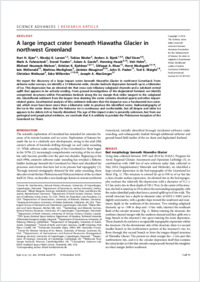A large impact crater beneath Hiawatha Glacier in northwest Greenland
- Kjær, Kurt H. Centre for GeoGenetics, Natural History Museum, University of Copenhagen, Denmark.
- Larsen, Nicolaj K. Centre for GeoGenetics, Natural History Museum, University of Copenhagen, Denmark. - Department of Geoscience, Aarhus University, Aarhus, Denmark.
- Binder, Tobias Alfred Wegener Institute, Helmholtz Centre for Polar and Marine Research, Bremerhaven, Germany.
- Bjørk, Anders A. Centre for GeoGenetics, Natural History Museum, University of Copenhagen, Denmark. - Department of Earth System Science, University of California, Irvine, USA. - NASA Jet Propulsion Lab, Pasadena, USA.
- Eisen, Olaf Alfred Wegener Institute, Helmholtz Centre for Polar and Marine Research, Bremerhaven, Germany. - Department of Geosciences, University of Bremen, Germany.
- Fahnestock, Mark A. Geophysical Institute, University of Alaska Fairbanks, USA.
- Funder, Svend Centre for GeoGenetics, Natural History Museum, University of Copenhagen, Denmark.
- Garde, Adam A. Geological Survey of Denmark and Greenland, Copenhagen, Denmark.
- Haack, Henning Maine Mineral and Gem Museum, Bethel, USA. - Geobiology and Minerals Section, Natural History Museum, University of Copenhagen, Denmark.
- Helm, Veit Alfred Wegener Institute, Helmholtz Centre for Polar and Marine Research, Bremerhaven, Germany.
- Houmark-Nielsen, Michael Centre for GeoGenetics, Natural History Museum, University of Copenhagen, Denmark.
- Kjeldsen, Kristian K. Centre for GeoGenetics, Natural History Museum, University of Copenhagen, Denmark. - Geological Survey of Denmark and Greenland, Copenhagen, Denmark. - Department of Earth Sciences, University of Ottawa, Canada.
- Khan, Shfaqat A. DTU Space, National Space Institute, Department of Geodesy, Technical University of Denmark, Kongens Lyngby, Denmark.
- Machguth, Horst Department of Geosciences, University of Fribourg, Switzerland. - Department of Geography, University of Zurich, Switzerland.
- McDonald, Iain School of Earth and Ocean Sciences, Cardiff University, Park Place, Cardiff, UK.
- Morlighem, Mathieu Department of Earth System Science, University of California, Irvine, USA.
- Mouginot, Jérémie Department of Earth System Science, University of California, Irvine, USA. - Université Grenoble Alpes, CNRS, INP, Grenoble, France.
- Paden, John D. Center for Remote Sensing of Ice Sheets, University of Kansas, Lawrence, USA.
- Waight, Tod E. Department of Geosciences and Natural Resources Management, University of Copenhagen, Denmark.
- Weikusat, Christian Alfred Wegener Institute, Helmholtz Centre for Polar and Marine Research, Bremerhaven, Germany.
- Willerslev, Eske Centre for GeoGenetics, Natural History Museum, University of Copenhagen, Denmark. - Department of Zoology, University of Cambridge, Cambridge, UK. - Wellcome Trust Sanger Institute, Hinxton, Cambridgeshire, UK.
- MacGregor, Joseph A. Cryospheric Sciences Lab, NASA Goddard Space Flight Center, Greenbelt, USA.
-
01.11.2018
Published in:
- Science Advances. - 2018, vol. 4, no. 11, p. eaar8173
English
We report the discovery of a large impact crater beneath Hiawatha Glacier in northwest Greenland. From airborne radar surveys, we identify a 31-kilometer-wide, circular bedrock depression beneath up to a kilometer of ice. This depression has an elevated rim that cross-cuts tributary subglacial channels and a subdued central uplift that appears to be actively eroding. From ground investigations of the deglaciated foreland, we identify overprinted structures within Precambrian bedrock along the ice margin that strike tangent to the subglacial rim. Glaciofluvial sediment from the largest river draining the crater contains shocked quartz and other impact-related grains. Geochemical analysis of this sediment indicates that the impactor was a fractionated iron asteroid, which must have been more than a kilometer wide to produce the identified crater. Radiostratigraphy of the ice in the crater shows that the Holocene ice is continuous and conformable, but all deeper and older ice appears to be debris rich or heavily disturbed. The age of this impact crater is presently unknown, but from our geological and geophysical evidence, we conclude that it is unlikely to predate the Pleistocene inception of the Greenland Ice Sheet.
- Faculty
- Faculté des sciences et de médecine
- Department
- Département de Géosciences
- Language
-
- English
- Classification
- Geology
- License
- License undefined
- Identifiers
-
- RERO DOC 323830
- DOI 10.1126/sciadv.aar8173
- Persistent URL
- https://folia.unifr.ch/unifr/documents/307201
Statistics
Document views: 105
File downloads:
- mac_lic.pdf: 178
